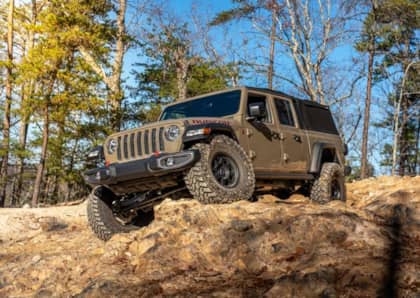1982-1986 Toyota Celica Supra Set The Bar For Japanese GT Imports
In the early 1980s, Toyota's fledgling sports car division needed a win. Faced with an onslaught of affordable hatchbacks and coupes on the American market, including a healthy contingent hailing from its homeland, the company hadn't been able to gain much traction among fun-seeking shoppers. With everyone from Datsun to Mazda to Porsche to Mitsubishi getting in on the fun—and with Detroit throwing small-displacement versions of the Camaro and Mustang into the ring—there were dollars to be had for the Japanese giant, if only it could figure out how to crack the high performance code.

Enter the 1982-1986 Toyota Celica Supra. After a largely overlooked attempt to market the nameplate as a personal luxury coupe at the end of the 1970s, the decision to pursue a more aggressive Celica Supra concept would have a galvanizing effect on Toyota's American fortunes. The A60 generation car would for the first time associate the words 'Supra' and 'sport,' creating a handsome, fun-to-drive coupe that would set the tone for the model for the next two decades.
Big Hatch, Big Six
While the smaller Celica was offered in a number of different body styles, the American Celica Supra forged ahead exclusively in two-door hatchback form. In addition to its larger size, it also gained a number of other styling cues that would separate it from the more affordable Toyota, as well as its premium-oriented predecessor. Key among those were a set of hideaway headlights up front and a large roof-mounted rear spoiler, each of which enhancing the car's ultra-80s wedge shape.
Also important in the Celica Supra's differentiation was the installation of an independent rear suspension in place of the live axle setup employed by both the first-generation car and the more affordable Celica. This was paired with a dead-reliable 5M-GE twin-cam inline six-cylinder engine, a 2.8-liter fuel-injected unit that produced between 145 and 160 horsepower and up to 169 lb-ft of torque, depending on the model year. A standard 5-speed manual gearbox stirred the drink, but a 4-speed automatic was also available on the options sheet.

Toyota offered the Celica Supra in two distinct versions: the L-Type, which was oriented towards comfort, and the P-Type, which aimed at a sport-seeking buyer. The difference between the two was largely options access, interior accoutrements (P-Type cars came with aggressively-bolstered thrones, leather was L-Type only for the first few years), and flared fenders on P-Type cars to accommodate wider tires.
Fun And Comfortable
How did the Celica Supra fare on the very competitive early 80s scene? Contemporary road tests placed the car near the top of the pack, running neck-and-neck with European and Japanese competitors alike. The sprint to 60-mph was accomplished in 8 seconds, which was robust for the period, and certainly in keeping with some of the sadder V8 'muscle' machines available from Ford and Chevrolet.

From a modern perspective, the Toyota feels like a capable and comfortable grand touring car, regardless of trim. Although not as light as a same-year RX-7, the car's 3,000 lbs of curb weight are masked by steady, composed handling and competent, if not thrilling thrust from its straight-six engine. The Celica Supra holds up well from an amenities standpoint, too, with power windows and door locks, a funky multi-band equalizer for the stereo system, and fun 80s graphics helping to create an enjoyable road trip environment.
Last Of Its Kind
By 1985 Toyota would stop production of the Celica Supra, but the replacement wouldn't be ready until 1987, which meant P-Type cars built the year before would continue to be sold to plug the gap as '86 models. When the new car did arrive, it represented another shift in attitude for the Supra, moving away from the Celica nomenclature entirely and embracing the grand touring segment with a larger, and significantly heavier vehicle. Helping to offset the additional 600 lbs gained by the MKIII Supra, as it became known, was a turbocharged inline-six engine that would bridge the gap between the more sprightly Celica Supra and the 2JZ-bearing MKIV Supra that would follow it.
Trouble-Free Classic
The primary challenge in finding a suitable Toyota Celica Supra today is dealing with the terrible toll exacted by rust. Like many of its contemporaries, the A60 Supra didn't respond well to road salt, and has been all but eliminated in the northeastern areas of the country. You won't find any companies supplying replacement body panels for the car, either, so a clean example is a must.

Aside from that asterisk, however, the coupe is generally inexpensive to own and easy to maintain, provided you don't mind spending the time required to hunt down trim pieces and other Supra-specific components that are no longer available from Toyota. Mechanically, there are few concerns other than worn syncros in manual transmission vehicles and occasional leaks from the valve cover gaskets.
Another part of the Supra appeal? Simplicity. The dependable, naturally-aspirated 5M-GE holds no surprises, apex seals, or turbo plumbing to confound restoration and enjoyment 30 years past it s on-sale date. The Celica Supra is one of the most plug-and-play early 80s sports cars still available at bargain pricing—and if you truly do want to complicate things, there's a rumor that the MKIII's 7M-GTE is as close to a drop-in swap as you can get.
Want to learn more about the current Supra? Click here for the latest on Toyota's redesigned sports car.







